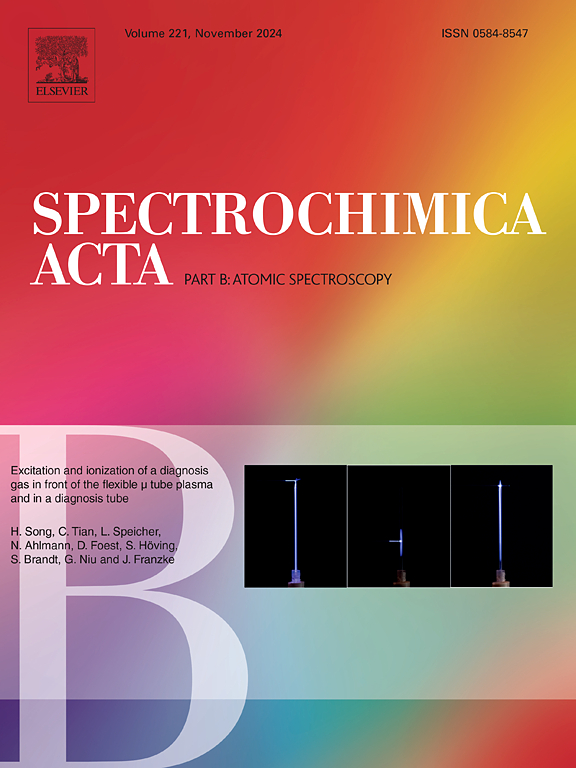用激光诱导击穿光谱法精确测定体外循环透析液中电解质阳离子
IF 3.2
2区 化学
Q1 SPECTROSCOPY
引用次数: 0
摘要
血液透析作为终末期肾病患者的主要肾脏替代疗法,需要监测透析液中的电解质阳离子,以确保治疗的安全性和有效性。相关元素包括钙、钾和钠。目前,流行的检测方法在提供现场和实时检测能力方面存在不足,这突出了创新的必要性。用激光诱导击穿光谱(LIBS)对散装液体进行元素分析,为透析监测提供了一个有趣的潜力。方法学研究应进一步致力于在透析液中同时实现高准确度和精密度的多元素测定,使用与流动透析液兼容的安排,并准备在临床环境中部署。在这项工作中,我们开发了一种专门用于透析分析的实验安排,将优化的LIBS设置集成到循环透析系统中,以模拟临床操作。这样的安排允许在流动的透析液中产生稳定而热的等离子体。钙、钾和钠的发射谱线随后被一个检测系统捕获,该检测系统经过优化,可以同时检测这三种元素,其浓度与实际透析液的浓度相对应。由于谱线的自吸收,特别是钠d谱线的自反转,单变量回归通常对处理液体中电解质阳离子的LIBS谱有效,但发现不足以提供满足临床实践要求的分析性能。本文提出了基于多元回归的数据处理方法,大大提高了模型的预测性能。更具体地说,与特征选择相结合的反向传播神经网络(BPNN)证明了利用由于特征线的自吸收和自反转而严重变形的频谱的复杂性的有效性。所得模型对Ca、K和Na的检出限分别为0.302、0.571和4.25 mmol/L。采用独立检验样本评估模型的预测性能,Ca、K和Na的预测均方根误差(RMSEP)分别为0.106、0.137和0.646 mmol/L。这些性能满足临床对透析液中电解质阳离子监测的要求。本文章由计算机程序翻译,如有差异,请以英文原文为准。

Precise determination of electrolyte cations in an extracorporeally circulating dialysate with laser-induced breakdown spectroscopy
Hemodialysis as the primary renal replacement therapy for patients afflicted by end-stage renal disease, necessitates monitoring of electrolyte cations in the dialysate to ensure the safety and efficacy of the treatment. Concerned elements include calcium, potassium, and sodium. Currently, prevailing detection methods fall short in providing in situ and real-time detection capabilities, highlighting the need of innovation. Elemental analysis of bulk liquids with laser-induced breakdown spectroscopy (LIBS) presents an interesting potential for dialysate monitoring. Methodological research should further aim to achieve simultaneous multi-element determinations in dialysates with high accuracy and precision, using an arrangement compatible with a flowing dialysate and ready for deployment in a clinical environment. In this work, we developed an experimental arrangement tailored for dialysate analysis, integrating an optimized LIBS setup into a circulating dialysate system, which simulated the clinical operation. Such an arrangement allowed generating a stable and hot plasma within a flowing dialysate. The emission lines from calcium, potassium, and sodium were subsequently captured by a detection system optimized for a simultaneous detection of the three elements with concentrations corresponding to those of a real dialysate. Due to self-absorption of the lines, notably self-reversal of the sodium D-lines, univariate regression, usually efficient for processing LIBS spectra of electrolyte cations in a liquid, was revealed insufficient to provide an analytical performance satisfying the requirements of the clinical practice. Data processing based on multivariate regression was thus developed in this work to substantially improve the model prediction performances. More specifically, back-propagation neural networks (BPNN) coupled with feature selection demonstrated the effectiveness to harness the complexity of the spectrum heavily deformed by self-absorption and self-reversal of the characteristic lines. The resulted models exhibit a limit of detection (LOD) of 0.302, 0.571, and 4.25 mmol/L, respectively for Ca, K, and Na. The prediction performances of the trained models were assessed using independent test samples, yielding root mean square errors of prediction (RMSEP) of 0.106, 0.137, and 0.646 mmol/L for Ca, K, and Na, respectively. Such performances satisfy the clinical requirements for monitoring of electrolyte cations in a dialysate.
求助全文
通过发布文献求助,成功后即可免费获取论文全文。
去求助
来源期刊
CiteScore
6.10
自引率
12.10%
发文量
173
审稿时长
81 days
期刊介绍:
Spectrochimica Acta Part B: Atomic Spectroscopy, is intended for the rapid publication of both original work and reviews in the following fields:
Atomic Emission (AES), Atomic Absorption (AAS) and Atomic Fluorescence (AFS) spectroscopy;
Mass Spectrometry (MS) for inorganic analysis covering Spark Source (SS-MS), Inductively Coupled Plasma (ICP-MS), Glow Discharge (GD-MS), and Secondary Ion Mass Spectrometry (SIMS).
Laser induced atomic spectroscopy for inorganic analysis, including non-linear optical laser spectroscopy, covering Laser Enhanced Ionization (LEI), Laser Induced Fluorescence (LIF), Resonance Ionization Spectroscopy (RIS) and Resonance Ionization Mass Spectrometry (RIMS); Laser Induced Breakdown Spectroscopy (LIBS); Cavity Ringdown Spectroscopy (CRDS), Laser Ablation Inductively Coupled Plasma Atomic Emission Spectroscopy (LA-ICP-AES) and Laser Ablation Inductively Coupled Plasma Mass Spectrometry (LA-ICP-MS).
X-ray spectrometry, X-ray Optics and Microanalysis, including X-ray fluorescence spectrometry (XRF) and related techniques, in particular Total-reflection X-ray Fluorescence Spectrometry (TXRF), and Synchrotron Radiation-excited Total reflection XRF (SR-TXRF).
Manuscripts dealing with (i) fundamentals, (ii) methodology development, (iii)instrumentation, and (iv) applications, can be submitted for publication.

 求助内容:
求助内容: 应助结果提醒方式:
应助结果提醒方式:


